

Even Physicists Don’t Understand Quantum Mechanics. Until physicists definitively answer these questions, they can’t really be said to understand quantum mechanics — thus Feynman’s lament.

Which is bad, because quantum mechanics is the most fundamental theory we have, sitting squarely at the center of every serious attempt to formulate deep laws of nature. If nobody understands quantum mechanics, nobody understands the universe. You would naturally think, then, that understanding quantum mechanics would be the absolute highest priority among physicists worldwide. Investigating the foundations of quantum theory should be a glamour specialty within the field, attracting the brightest minds, highest salaries and most prestigious prizes. Physicists, you might imagine, would stop at nothing until they truly understood quantum mechanics. The reality is exactly backward. Physicists Find a Way to See the ‘Grin’ of Quantum Gravity. In 1935, when both quantum mechanics and Albert Einstein’s general theory of relativity were young, a little-known Soviet physicist named Matvei Bronstein, just 28 himself, made the first detailed study of the problem of reconciling the two in a quantum theory of gravity.
This “possible theory of the world as a whole,” as Bronstein called it, would supplant Einstein’s classical description of gravity, which casts it as curves in the space-time continuum, and rewrite it in the same quantum language as the rest of physics. Bronstein figured out how to describe gravity in terms of quantized particles, now called gravitons, but only when the force of gravity is weak — that is (in general relativity), when the space-time fabric is so weakly curved that it can be approximated as flat.
When gravity is strong, “the situation is quite different,” he wrote. Dr Quantum - Double Slit Experiment. Understanding 4th Dimention - HQ. "Quantum Darwinism" Sounds Mind-Breaking, But This Theory Is Passing Tests. When it comes to our physical world, scientific research indicates that size really does matter.
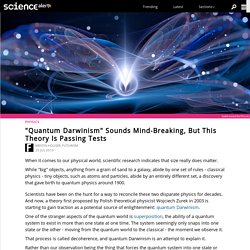
While "big" objects, anything from a grain of sand to a galaxy, abide by one set of rules - classical physics - tiny objects, such as atoms and particles, abide by an entirely different set, a discovery that gave birth to quantum physics around 1900. Scientists have been on the hunt for a way to reconcile these two disparate physics for decades. Discovery of Time Crystals Could Radically Change Our Understanding of the Space-Time Continuum.
Consider a structure that moves not in space but time, crystals that change shape and move perpetually without energy, and always return to their original state.
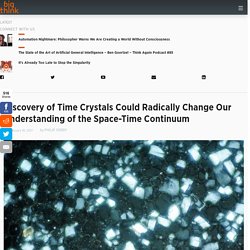
Such a structure would break the second law of thermodynamics, a cardinal rule of physics. Yet, in 2012, Nobel Laurette and theoretical physicist Frank Wilczek imagined them, what he called time crystals. Their movement isn’t of their own accord. Instead, a fracture in time’s symmetry allows for them to stay in perpetual motion. Why crystals? Controlled Quantum Dynamics Group. Biologists do not take a quantum physics course during their studies because so far they were able to make sense of biological phenomena without using the counterintuitive laws of physics that govern the atomic scale.

However, in recent years progress in experimental technology has revealed that quantum phenomena are relevant for fundamental biological processes such as photosynthesis, magneto-reception and olfaction. We have helped to initiate the development of this research field and are now working to discover how nature is harnessing quantum dynamics to optimize biological function. S.F. Huelga and M.B. Plenio. Scientists Discover a Jewel at the Heart of Quantum Physics. Physicists reported this week the discovery of a jewel-like geometric object that dramatically simplifies calculations of particle interactions and challenges the notion that space and time are fundamental components of reality.

“This is completely new and very much simpler than anything that has been done before,” said Andrew Hodges, a mathematical physicist at Oxford University who has been following the work. The revelation that particle interactions, the most basic events in nature, may be consequences of geometry significantly advances a decades-long effort to reformulate quantum field theory, the body of laws describing elementary particles and their interactions. Interactions that were previously calculated with mathematical formulas thousands of terms long can now be described by computing the volume of the corresponding jewel-like “amplituhedron,” which yields an equivalent one-term expression. The amplituhedron itself does not describe gravity.
Researchers at Brown University shattered an electron wave function. A team of physicists based at Brown University has succeeded in shattering a quantum wave function.
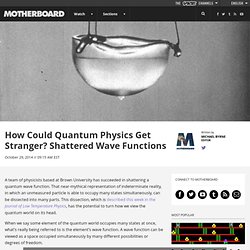
That near-mythical representation of indeterminate reality, in which an unmeasured particle is able to occupy many states simultaneously, can be dissected into many parts. This dissection, which is described this week in the Journal of Low Temperature Physics, has the potential to turn how we view the quantum world on its head. When we say some element of the quantum world occupies many states at once, what’s really being referred to is the element’s wave function. A wave function can be viewed as a space occupied simultaneously by many different possibilities or degrees of freedom. If a particle could be in position (x,y,z) in three-dimensional space, there are probabilities that it could specifically be at (x1,y1,z1) or (x2,y2,z2) and so forth, and this is represented in the wave function, which is all of these possibilities added together.
When Parallel Worlds Collide . . . Quantum Mechanics Is Born. Parallel universes – worlds where the dinosaur-killing asteroid never hit, or where Australia was colonised by the Portuguese – are a staple of science fiction.
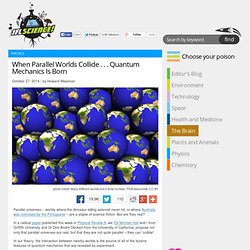
But are they real? In a radical paper published this week in Physical Review X, we (Dr Michael Hall and I from Griffith University and Dr Dirk-André Deckert from the University of California) propose not only that parallel universes are real, but that they are not quite parallel – they can “collide”. Hawking Radiation Recreated In A Laboratory. A researcher claims to have produced a simulation of Hawking radiation, which if true will give physicists the chance to test one of Stephen Hawking's most significant predictions.
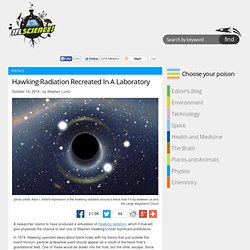
In 1974, Hawking upended ideas about black holes with his theory that just outside the event horizon, particle-antiparticle pairs should appear as a result of the black hole's gravitational field. One of these would be drawn into the hole, but the other escape. Since the appearance of the pair draws energy from the hole and only half of this is recaptured, the effect is to reduce the hole's mass, causing it to eventually evaporate. Physicists Achieve Quantum Teleportation of Photon Over 25 Kilometers. For the first time, a team of physicists have successfully teleported a quantum state of a photon to a crystal over 25 kilometers away through a fiber optic cable.
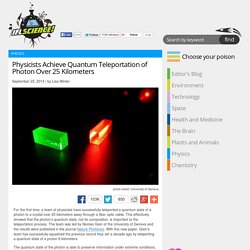
This effectively showed that the photon’s quantum state, not its composition, is important to the teleportation process. The team was led by Nicolas Gisin of the University of Geneva and the results were published in the journal Nature Photonics. World’s First Perpetual Motion Machine? Can this machine operate forever?

Since at least the 12th century, man has sought to create a perpetual motion machine; a device that would continue working indefinitely without any external source of energy. Common Physics Misconceptions. Hypercube Demonstration. An Idiot's Guide to Teleportation » SciFi Ideas / SciFi Ideas. With contributor Harel Dor recently sharing with SciFi Ideas a story idea that makes full use of teleportation technology – Meet the Beamies – I thought it was high time we discussed teleportation in detail. Teleportation is one of science fiction’s most fascinating and useful ideas, being both a cool gadget and a clever narrative device; however, with lots of talk about quantum entanglement, ideas about how teleportation might actually be achieved can also be very complex.
To help you understand what the science geeks are talking about and dispel some of the myths about the reality of teleportation, here’s an idiot’s guide to what this word actually means. Is Teleportation Possible? Teleportation is impossible. Teleportation has also been achieved. What I mean by the above statement is that there are actually two types of teleportation – two definitions in use in both contemporary science fiction and modern physics. The Quantum Mechanics of Time Travel. Higgs Boson Part III: How to Discover a Particle. Imagining the Tenth Dimension part 1 of 2.
Quantum Breakthrough: Physicists Have Once More Created Time Crystals. Quantum entanglement, science’s ‘spookiest’ phenomenon, achieved in space. Quantum batteries could allow for super-fast charging thanks to entanglement. This site may earn affiliate commissions from the links on this page. Terms of use. As mobile devices get more powerful, they also burn through batteries at an ever increasing rate. Capacities have been inching upward over the years, but one of the biggest improvements has been fast-charging technologies like Qualcomm’s Quick Charge 2.0 and Oppo’s VOOC. However, physicists have discovered a way that future batteries could charge at warp speed by leveraging quantum entanglement. You’re probably familiar with quantum bits (qubits) to some degree from all the news about quantum computing in recent years. Dark Energy May Be Incompatible With String Theory. On June 25, Timm Wrase awoke in Vienna and groggily scrolled through an online repository of newly posted physics papers.
One title startled him into full consciousness. The paper, by the prominent string theorist Cumrun Vafa of Harvard University and collaborators, conjectured a simple formula dictating which kinds of universes are allowed to exist and which are forbidden, according to string theory. Closed Loophole Confirms the Unreality of the Quantum World.
The theoretical physicist John Wheeler once used the phrase “great smoky dragon” to describe a particle of light going from a source to a photon counter. “The mouth of the dragon is sharp, where it bites the counter. Quantum leaps are real – and now we can control them. Belisarius Productions/Universal Television By Leah Crane. Scientists Have Found Evidence a Strange Group of Quantum Particles Are Basically Immortal. Nothing lasts forever. Physicists Have Reversed Time on The Smallest Scale by Using a Quantum Computer. It's easy to take time's arrow for granted - but the gears of physics actually work just as smoothly in reverse. Researchers for the first time report quantum teleportation in qutrit.
Physicists Entangled Photons in the Lab With Photons From the Sun.